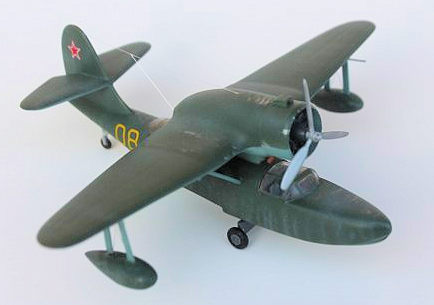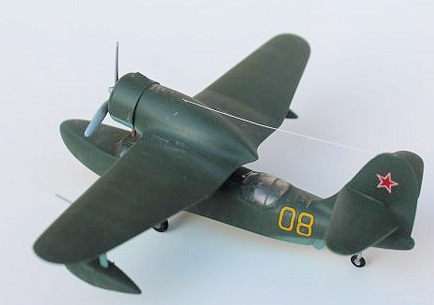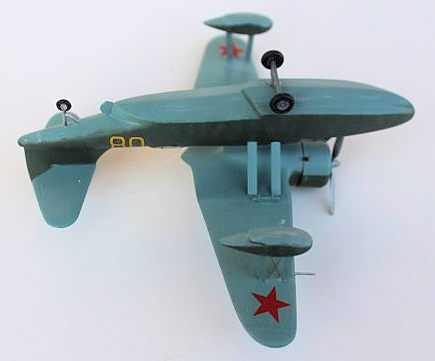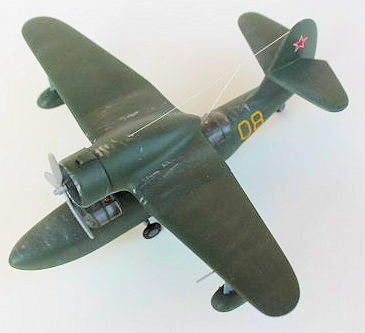
RPM 1/72 Beriev Be.4/KOR-2
| KIT #: | 72023 |
| PRICE: | $ |
| DECALS: | Six options |
| REVIEWER: | Brian Baker |
| NOTES: | Short run |

| HISTORY |
 As the
Beriev design team was developing the KOR-1 two seat float biplane for Soviet
Navy shipboard operations, they also began designing on parallel the more
advanced KOR-2 flying boat for the same requirement. The result was a small,
high performance two or three place flying boat powered by a massive 1,000 hp.
M-62 radial engine swinging a three bladed metal propeller. The structure was
all-metal, with fabric covered control surfaces. The parasol wing was an
inverted gull type to allow clearance for the prop over the fuselage. Fixed
floats were mounted near the wingtips. A crew of two or three was carried, a
pilot and a rear gunner. Armament consisted of two 7.62 mm. ShKAS machine guns,
one fixed in a forward firing position, and the other operated by the gunner in
the rear seat.
As the
Beriev design team was developing the KOR-1 two seat float biplane for Soviet
Navy shipboard operations, they also began designing on parallel the more
advanced KOR-2 flying boat for the same requirement. The result was a small,
high performance two or three place flying boat powered by a massive 1,000 hp.
M-62 radial engine swinging a three bladed metal propeller. The structure was
all-metal, with fabric covered control surfaces. The parasol wing was an
inverted gull type to allow clearance for the prop over the fuselage. Fixed
floats were mounted near the wingtips. A crew of two or three was carried, a
pilot and a rear gunner. Armament consisted of two 7.62 mm. ShKAS machine guns,
one fixed in a forward firing position, and the other operated by the gunner in
the rear seat.
The aircraft first flew in October, 1940, at the Beriev factory at Taganrog, and series production began in 1941 under the designation Be-4. When the Germans invaded, the plant was packed up and moved two times, winding up in Krasnoyarsk, and a total of 47 BE-4ís was produced between 1943 and 1945.
The planes equipped the Soviet Black Sea Fleet from 1942 until 1945. They were used mainly for coastal reconnaissance, transport, and anti-submarine operations. They also operated as catapult seaplanes from the cruisers Kirov and Maxim Gorki.
| THE KIT |
 There
have apparently been several kits issued of this model. Burnsí Guide lists
A-Model, Boleslav, CMK/CMR, Czechmasters, KPM, Omega, RPM, and Wings. Some of
these are certainly vacuform or resin. This is the only one of these kits I have
seen. For all I know, they may possibly all be the same kit.
There
have apparently been several kits issued of this model. Burnsí Guide lists
A-Model, Boleslav, CMK/CMR, Czechmasters, KPM, Omega, RPM, and Wings. Some of
these are certainly vacuform or resin. This is the only one of these kits I have
seen. For all I know, they may possibly all be the same kit.
The kit consists of two sprues of light colored styrene plastic and two clear plastic canopy parts in a sealed plastic bag. The molding seems rather crude, but it is not over-detailed, and is easy to smooth out to remove the flash. Panel lines are almost invisible, and control surface lines are just barely visible. At least they didnít overdo it.
The instructions are printed on one large 12Ē x 16Ē sheet of newsprint, the first sheet providing a history and instructions in Polish, along with profile views of the six aircraft for which decals are provided, while the second half of the sheet has a sprue diagram and six assembly drawings showing numbered parts. The backside is blank.
| CONSTRUCTION |
Assembly of the kit is quite
simple, considering its complexity. The powerplant assembly consists of a one
piece cowling, a nicely detailed radial engine which fits nicely inside the
cowling, a prop with spinner attached, and a carburetor air intake which fits on
top of the cowl. The fuselage has two main sections, two cockpit floors, four
bulkheads, one of which is an instrument panel, two pilotís seats, and a
gunnerís bench. Once the interior parts are assembled, and the fuselage halves
are joined, the wing and other parts can be put in place. One thing the kit does
not include is a three-view drawing of the airplane, and this would be very
useful in the process. These are available on line, and I have included one
here. The wing consists of a two-part center section, and two part outer wing
panels. These assure the correct wing dihedral, so it is almost
 impossible
to get this in the wrong position. The wingtip floats are cast in two halves,
and the struts need to be glued to the floats after they are dried. There are
parallel wing bracing struts to be attached after the wings are in position, but
there are no tailplane struts or wires. In fact, the only wires I attached
anywhere on the airplane were bracing wires in between the float struts, and
also a wire low frequency radio antenna. These are not shown in the
instructions, but on line drawings and photos show them. In addition, there is a
small steering water-rudder at the rear of the main float included, and it is
shown on the box art. There is no mention in the kit instructions of a wheeled
beaching undercarriage, although an on-line photo shows this. This allows the
rear steering rudder to stay clear of the ground. Photos show a small tailwheel
and main beaching wheels on the hull just ahead of the center of gravity, and I
attached these so that the airplane would sit in the proper position with the
water rudder clearing the ground by about a foot. In addition, I added small
bomb racks just outboard of the main wing struts, probably for depth charges for
anti-submarine. These were probably attached to only some of the aircraft. I
used wing racks from an old Airfix FW-190A kit, and they worked quite well.
impossible
to get this in the wrong position. The wingtip floats are cast in two halves,
and the struts need to be glued to the floats after they are dried. There are
parallel wing bracing struts to be attached after the wings are in position, but
there are no tailplane struts or wires. In fact, the only wires I attached
anywhere on the airplane were bracing wires in between the float struts, and
also a wire low frequency radio antenna. These are not shown in the
instructions, but on line drawings and photos show them. In addition, there is a
small steering water-rudder at the rear of the main float included, and it is
shown on the box art. There is no mention in the kit instructions of a wheeled
beaching undercarriage, although an on-line photo shows this. This allows the
rear steering rudder to stay clear of the ground. Photos show a small tailwheel
and main beaching wheels on the hull just ahead of the center of gravity, and I
attached these so that the airplane would sit in the proper position with the
water rudder clearing the ground by about a foot. In addition, I added small
bomb racks just outboard of the main wing struts, probably for depth charges for
anti-submarine. These were probably attached to only some of the aircraft. I
used wing racks from an old Airfix FW-190A kit, and they worked quite well.
| COLORS & MARKINGS |
The instructions provide six different color schemes for the plane, and although they are only in Polish, it is easy to guess that they are combinations of dark green, pale blue, and some shade of brown. The box art shows a dark green over sky blue undersides. Some of the red stars had white outlines, while others did not. One option is to paint the aircraft entirely aluminum, and there is a photo of this plane on line. I opted for a standard green and blue scheme with a yellow ď04Ē on the rear fuselage. I think I guessed right.
| CONCLUSIONS |
This is a nice little model, and stands out in my collection of Russian aircraft. It is not Hasegawa/Airfix quality, but still make into a presentable model, although I donít think Iíll win any contests with it. However, it was fun, and a challenge, and isnít that what modeling is all about. Try one of these if you can find one. Recommended.
| REFERENCES |
 This
aircraft has some interesting reference material. On line references using
Google give the basic background, some photos, and good three view drawings
(included here). However, the plane is not mentioned in Greenís little book on
Flying Boats, published back in 1962. In fact, they have an article that claims
to describe the Beriev BE-4, but it actually describes a TWIN engine flying
boat, the Tchetverikov MDR-6, which was developed in 1938, and aside from the
engines, bears a faint resemblance to the Be-4. The author designates the
aircraft as BE-4, MDR-6, two entirely different aircraft. Just remember that the
Be-4/KORó2 is a SINGLE engine aircraft, and that should clear things up. Iíd
like to see a kit of the MDR-6, and there probably is one, but it is not the
aircraft listed in Greenís book. Websites show it to be a much larger twin
engine flying boat, codenamed Madge
and Mole
in the postwar NATO system. There are two kits of this
aircraft listed in Burnsí book, one in 1/72 scale and one in 1/48. Since there
is no photo of the aircraft in Greenís book, I wonder if the aircraft described
in the book actually existed. Comments, anyone?
This
aircraft has some interesting reference material. On line references using
Google give the basic background, some photos, and good three view drawings
(included here). However, the plane is not mentioned in Greenís little book on
Flying Boats, published back in 1962. In fact, they have an article that claims
to describe the Beriev BE-4, but it actually describes a TWIN engine flying
boat, the Tchetverikov MDR-6, which was developed in 1938, and aside from the
engines, bears a faint resemblance to the Be-4. The author designates the
aircraft as BE-4, MDR-6, two entirely different aircraft. Just remember that the
Be-4/KORó2 is a SINGLE engine aircraft, and that should clear things up. Iíd
like to see a kit of the MDR-6, and there probably is one, but it is not the
aircraft listed in Greenís book. Websites show it to be a much larger twin
engine flying boat, codenamed Madge
and Mole
in the postwar NATO system. There are two kits of this
aircraft listed in Burnsí book, one in 1/72 scale and one in 1/48. Since there
is no photo of the aircraft in Greenís book, I wonder if the aircraft described
in the book actually existed. Comments, anyone?
23 January 2020
Copyright ModelingMadness.com
If you would like your product reviewed fairly and fairly quickly, please contact the editor or see other details in the Note to Contributors.
Back to the Main Page Back to the Review Index Page Back to the Previews Index Page